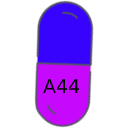Uses of Amoxicillin
Amoxicillin is used to treat certain infections caused by bacteria, such as pneumonia; bronchitis (infection of the airway tubes leading to the lungs); and infections of the ears, nose, throat, urinary tract, and skin. It is also used in combination with other medications to eliminate H. pylori, a bacteria that causes ulcers. Amoxicillin is in a class of medications called penicillin-like antibiotics. It works by stopping the growth of bacteria.
Antibiotics such as amoxicillin will not work for colds, flu, and other viral infections. Taking antibiotics when they are not needed increases your risk of getting an infection later that resists antibiotic treatment.
Side Effects of Amoxicillin
Amoxicillin may cause side effects. Tell your doctor if any of these symptoms are severe or do not go away:
- nausea
- vomiting
- diarrhea
- changes in taste
- headache
Some side effects can be serious. If you experience any of these symptoms, stop taking amoxicillin and call your doctor immediately or get emergency medical treatment:
- rash
- skin blisters or peeling
- itching
- hives
- wheezing
- difficulty swallowing or breathing
- swelling of the face, throat, tongue, lips, and eyes
- severe diarrhea (watery or bloody stools) that may occur with or without fever and stomach cramps (may occur up to 2 months or more after your treatment)
Amoxicillin may cause other side effects. Call your doctor if you have any unusual problems while taking this medication.
Warnings & Precautions
Before taking amoxicillin:
- tell your doctor and pharmacist if you are allergic to amoxicillin; penicillin antibiotics; cephalosporin antibiotics such as cefaclor, cefadroxil, cefazolin (Ancef, Kefzol), cefepime (Maxipime), cefixime (Suprax), cefotaxime (Claforan), cefotetan, cefoxitin (Mefoxin), cefpodoxime, cefprozil, ceftaroline (Teflaro), ceftazidime (Fortaz, Tazicef, in Avycaz), ceftibuten, ceftriaxone, cefuroxime (Ceftin, Zinacef), and cephalexin (Keflex); any other medications; or any of the ingredients in amoxicillin capsules, tablets, or suspension. Ask your pharmacist for a list of the ingredients.
- tell your doctor and pharmacist what other prescription and nonprescription medications, vitamins, nutritional supplements, and herbal products you are taking or plan to take. Be sure to mention any of the following: allopurinol (Lopurin, Zyloprim), other antibiotics, anticoagulants (‘blood thinners’) such as warfarin (Coumadin, Jantoven), oral contraceptives, and probenecid (Probalan, in Col-Probenecid). Your doctor may need to change the doses of your medications or monitor you carefully for side effects.
- tell your doctor if you have mononucleosis (a virus; also called ‘mono’) and if you have or have ever had kidney disease, allergies, asthma, hay fever, or hives.
- tell your doctor if you are pregnant, plan to become pregnant, or are breastfeeding. If you become pregnant while taking amoxicillin, call your doctor.
- if you have phenylketonuria (PKU, an inherited condition in which a special diet must be followed to prevent mental retardation), you should know that some amoxicillin chewable tablets are sweetened with aspartame that forms phenylalanine.
Dosage
Amoxicillin comes as a capsule, a tablet, a chewable tablet, and as a suspension (liquid) to take by mouth. It is usually taken every 12 hours (twice a day) or every 8 hours (three times a day) with or without food. The length of your treatment depends on the type of infection that you have. Take amoxicillin at around the same times every day. Follow the directions on your prescription label carefully, and ask your doctor or pharmacist to explain any part you do not understand. Take amoxicillin exactly as directed. Do not take more or less of it or take it more often than prescribed by your doctor.
Shake the suspension well before each use to mix the medication evenly. The suspension may be placed directly on the child’s tongue or added to the formula, milk, fruit juice, water, ginger ale, or another cold liquid and taken immediately.
The chewable tablets should be crushed or chewed thoroughly before they are swallowed.
Swallow the tablets and capsules whole with a full glass of water; do not chew or crush them.
You should begin to feel better during the first few days of treatment with amoxicillin. If your symptoms do not improve or get worse, call your doctor.
Take amoxicillin until you finish the prescription, even if you feel better. If you stop taking amoxicillin too soon or skip doses, your infection may not be completely treated and the bacteria may become resistant to antibiotics.
Other
Keep all appointments with your doctor and the laboratory. Your doctor may order certain lab tests to check your body’s response to amoxicillin.
If you are diabetic, use Clinistix or TesTape (not Clinitest) to test your urine for sugar while taking this medication.
Do not let anyone else take your medication. Your prescription is probably not refillable. If you still have symptoms of infection after you finish the amoxicillin, call your doctor.
It is important for you to keep a written list of all of the prescription and nonprescription (over-the-counter) medicines you are taking, as well as any products such as vitamins, minerals, or other dietary supplements. You should bring this list with you each time you visit a doctor or if you are admitted to a hospital. It is also important information to carry with you in case of emergencies.
Source
All information has been provided courtesy of MedLinePlus from the National Library of Medicine and from the FDA.



